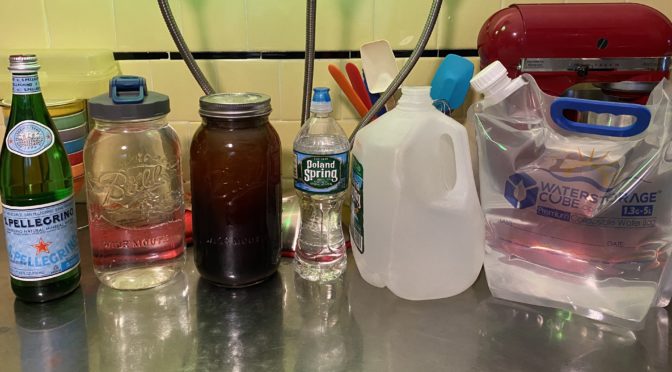The second category I would like to look at for winter prep is water. If you live in an area of the world, like New England, you will most likely be buried in some amount of snow for up to six months of the year. So, in the event of a real emergency, you can walk outside and get a bucket of snow and boil it for drinking and cleaning.
We have been in the path of hurricanes and tornadoes, but the most likely events that will effect our water supply, in reality, are broken pipes or blizzards. These are the things we prepare for, your possible situations may be different. When prepping for water storage for emergencies, FEMA recommends at least one gallon of water, per person, per day, for several days (for drinking and sanitation). They recommend 3 gallons of fluids for drinking each day, per person, so the amount we should have on hand is much higher than 1 gallon. Start with the 1 gallon each per day and add to it as you are able.
To begin with, it is good to know where water comes into your home and where it goes out of your home. This includes indoor and outdoor faucets, any turn-offs, toilets, sinks, bathtubs, showers, water heaters, steam furnaces, washing machine, dishwasher, etc. Each of these places has the potential for needing to be serviced or replaced over time. If you have a water leak within the home, it will be easier to troubleshoot a problem if you are aware of all of these locations. Do you know where the main shutoff is for water coming into your home? Do you know how to turn it off, if needed?
For our water prep, we have (glass) bottled water for drinking, several 1/2 gallon canning jars of filtered water for cold-brewing coffee, 1.3 gallon bags of water for cooking and hygiene, plastic water bottles for cleaning, and some drinking water stored for our rabbit. We also have a variety of juice, soda, etc. in the house at different times, but they aren’t constants that we would rely on.
As I said above, winter usually supplies its own water as we are often buried in snow. In summer, we use only rain water for our garden, and have rain barrels that hold 165 gallons of water. This is the equivalent, watering by hand, of at least two weeks of keeping our garden going if there were a water restriction or short-term dry period of summer. If you are frequently in your car, it is also good to have a case of water with you in the event of an emergency. If you live in a really hot climate, it isn’t advisable to keep plastic bottles of water in the heat of the car for an extended amount of time. It would be better to have a metal thermos that you bring with you to keep the drinking water cool.
If you are new to prepping, begin with minimums of food and water for each of your family members, for at least three days. When you have that, expand it to a week, and so on. If you aren’t sure what you need for food and water, use a small notebook and keep track of everything your family eats and drinks for a week and you will have a general idea of what is needed for preparedness.
I will be discussing the other possible extremes of needing to evacuate and worst case scenarios later this month which would require a portable water filtering system and additional ways of gathering water.

